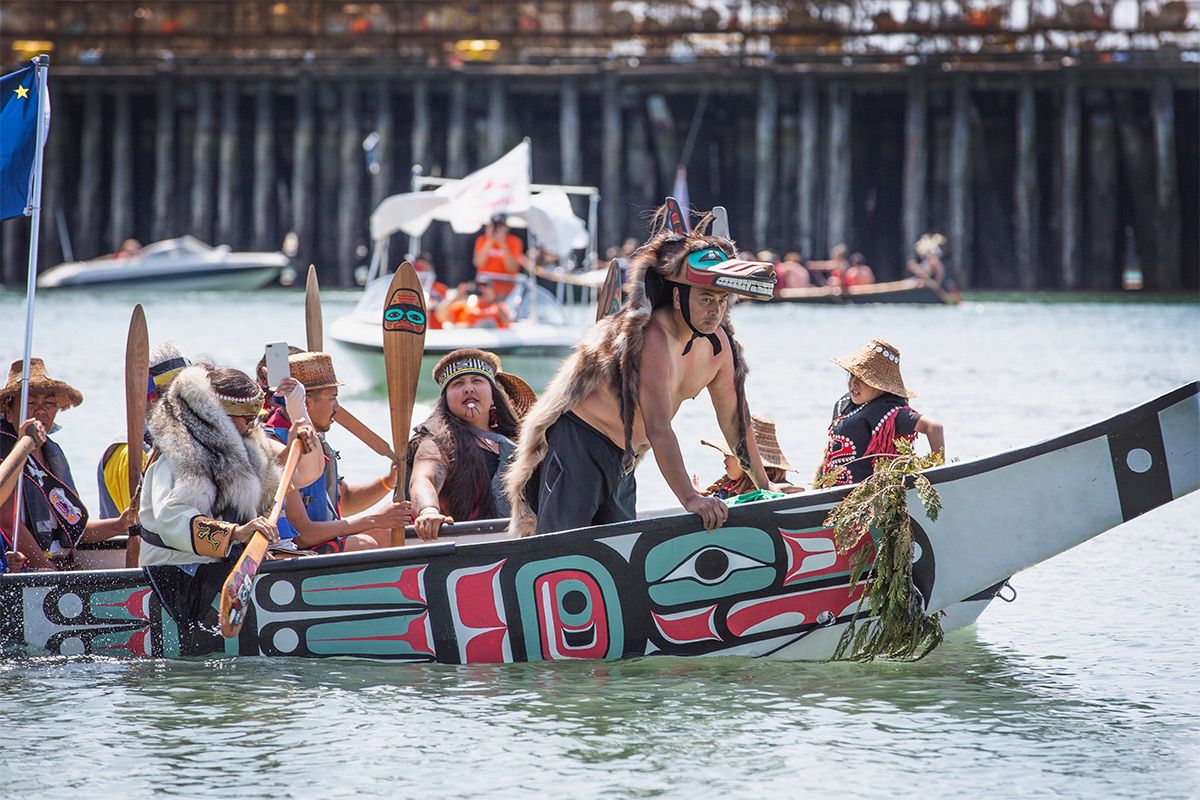Proposal
Tribal governments located on or near the southern, northern, and Alaska borders came together during the 2019 Tribal Border Summit to develop this government-to-government proposal. Tribes divided by international borders have the inherent right to maintain and develop contacts, relations, and spiritual, cultural, political, and economic activities with their citizens and relations. These inherent crossing rights have been recognized through treaties, both by the U.S. government and by international organizations. Although we, the border tribes, are separated by many miles and have distinct issues to address, we have much in common.
Unfortunately, tribal members crossing the borders are treated inconsistently due to the lack standardized training regarding their inherent crossing rights. For example, one southern tribe when crossing with a sacred deer mask for a ceremony had their mask forcibly ripped apart by border agents attempting to search the interior of the item. This item had passed through generations of tribal cultural leaders and is now desecrated and unusable. Similarly, several northern tribes, despite having a recognized inherent right to free passage across the northern border, have been stopped and harassed repeatedly by border personnel un-educated on their treaty rights. All tribal members who approach the borders to cross experience trauma because they never know if the agent will respect their inherent and recognized rights.
In recognition of our shared concerns we seek to provide practical tribal-driven solutions on how to secure our nation, all while respecting our traditional and cultural practices and protocols. In order to achieve this goal, the federal government must take a diverse approach in partnership with tribal governments to create border policies that address the needs of every border tribe.


Border-Crossing Specific Proposals
Amend Section 289 of the Immigration and Nationality Act (8 U.S.C. 1359)
The Jay Treaty of 1794 recognized the inherent rights of northern tribes and first nations to cross the U.S. and Canada borders. However, subsequent U.S. law required that tribal members prove they possess at least 50 percent blood quantum to exercise that right. Section 289 of the Immigration and Nationality Act should be amended to remove any reference to a blood quantum requirement for border crossings.
Development of an Indigenous Visa Category
Relatives of border tribes residing on the non-U.S. side of the border frequently need to cross the U.S. border to engage in traditional, and cultural activities, however, sometimes these activities can take weeks and no current visa category sufficiently addresses these needs. Border tribes that do not have a treaty-recognized right to free passage across the border seek consultation on the development of an Indigenous visa category that will allow these tribes to exercise their inherent crossing rights.
Tribal-Driven Common Sense Solutions to Border Security in Indian Country
Annual Consultation between the Department of Homeland Security and Tribal Governments. Tribal Governments are often the first and only line of defense for border security matters in Indian Country. In order to assure that all citizens and residents are safe, proper funding, coordination, and resources must be directly provided to tribal governments. Meaningful consultation with tribal governments is essential to identifying threats to border security and crafting tribal-appropriate solutions. At the annual consultation, DHS must provide an update report to tribal governments on their progress regarding issues identified by tribal governments at the previous year’s consultation.
Require National & Local Tribal Cultural Trainings for all CBP, ICE, and CIS Personnel
The Department of Homeland Security (DHS) must create and implement a policy requiring the consistent, standardized education of federal border personnel. The DHS education policy must require all personnel who may encounter tribal members or their relatives during their work as an employee of the U.S. Customs and Border Protection Agency (CBP), Immigration and Customs Enforcement (ICE), and United States Citizenship and Immigration Services (CIS) to complete a training on national tribal cultural awareness and sensitivity upon hiring (or if already employed when the trainings are finalized) and complete a second training focused on local tribal cultural awareness and sensitivity once they are assigned to a U.S. border location(s). The national tribal cultural awareness and sensitivity training must be developed in meaningful consultation with all border tribal governments. Additionally, the local tribal cultural awareness and sensitivity training must be developed in meaningful consultation with the locally impacted tribal governments. The final policy must cover at a minimum, all tribal crossing rights, including inherent rights; handling of cultural objects; respect of sacred sites and landscapes; traditional hunting and fishing rights; indigenous language awareness and providing translators; transportation of food and medicine for ceremonies; preservation of tribal plants and medicines; the crossing of tribal traditional practitioners; the treatment of indigenous people from traditional tribal territories near the U.S. border; and other cultural instances as requested by tribal governments through meaningful consultation.
Additionally, DHS must hire or designate a competent tribal liaison for every port of entry and checkpoint that tribal members and their relatives cross regularly along or near the U.S. border. These liaisons will coordinate with local tribal governments.
Direct, Sufficient, Flexible, and Consistent Funding for Tribal-Driven Border Security
In order to develop a strong border security program tribal governments must have access to direct, sufficient, flexible, and consistent funding. One-time funding cannot sustain tribal homeland security programs and results in dissolution or downsizing. The lack of flexibility in funding prevents tribal governments from adapting to evolving homeland security threats. When states receive funding that is intended as pass-through funds for tribes, they will frequently impose additional requirements on those funds or fail to pass through any funding. It is clear that the only funding that can create and sustain tribal-driven border security programs must be direct, sufficient, flexible, and consistent. Additional funding should focus on the following areas:
- Tribal Law Enforcement, including but not limited to Cross-Deputization Efforts and Other Cooperative Law Enforcement Agreements
- Human Trafficking
- Drug Trafficking
- Missing and Murdered Indigenous Women, Men, Children, and LGBTQ
- Cyber Security
- Terrorism
- Impacts to Tribal Governments Caused by Unauthorized Border Crossings
- Additional Border Issues as Expressed by Tribal Governments During Consultation